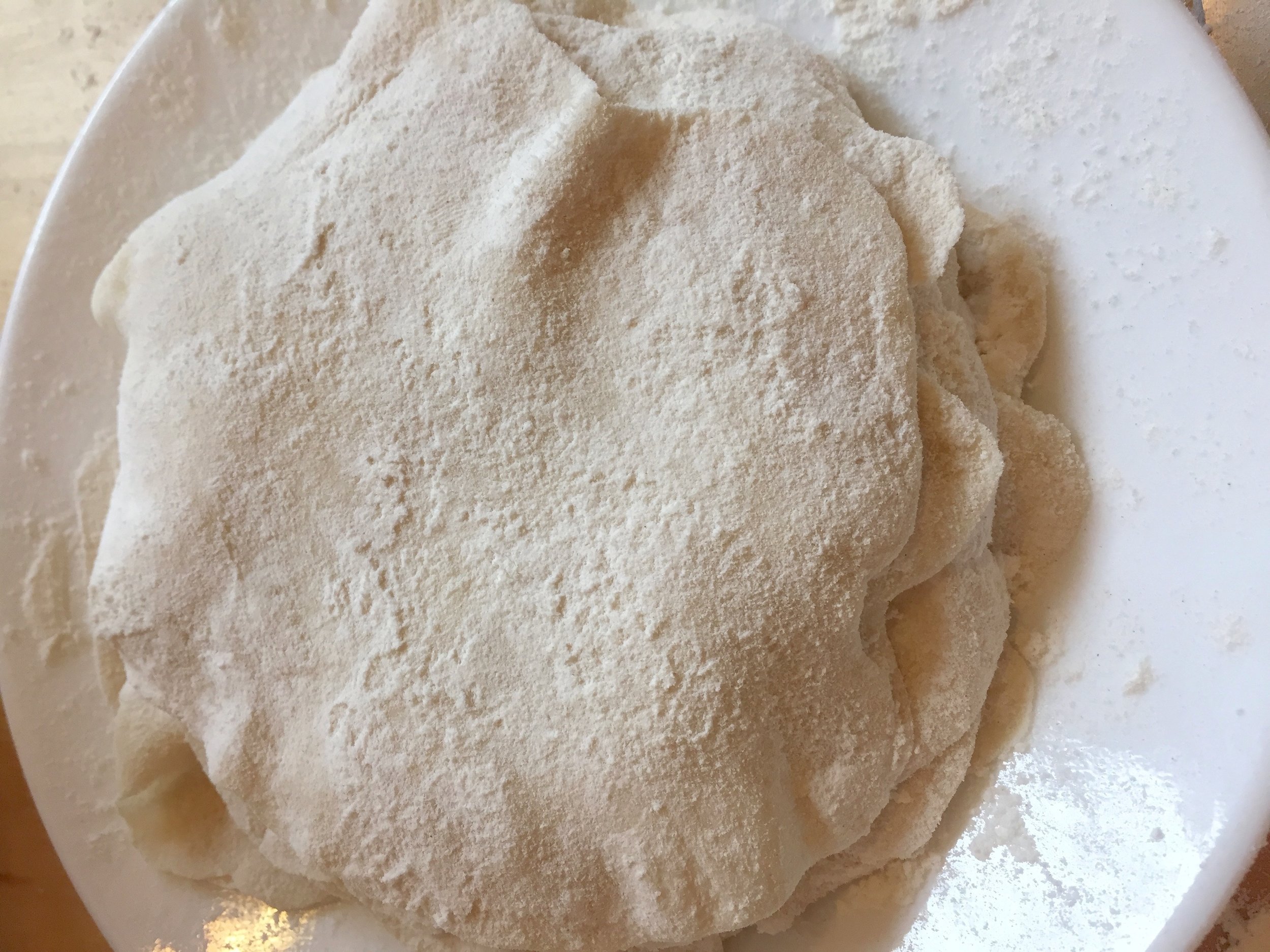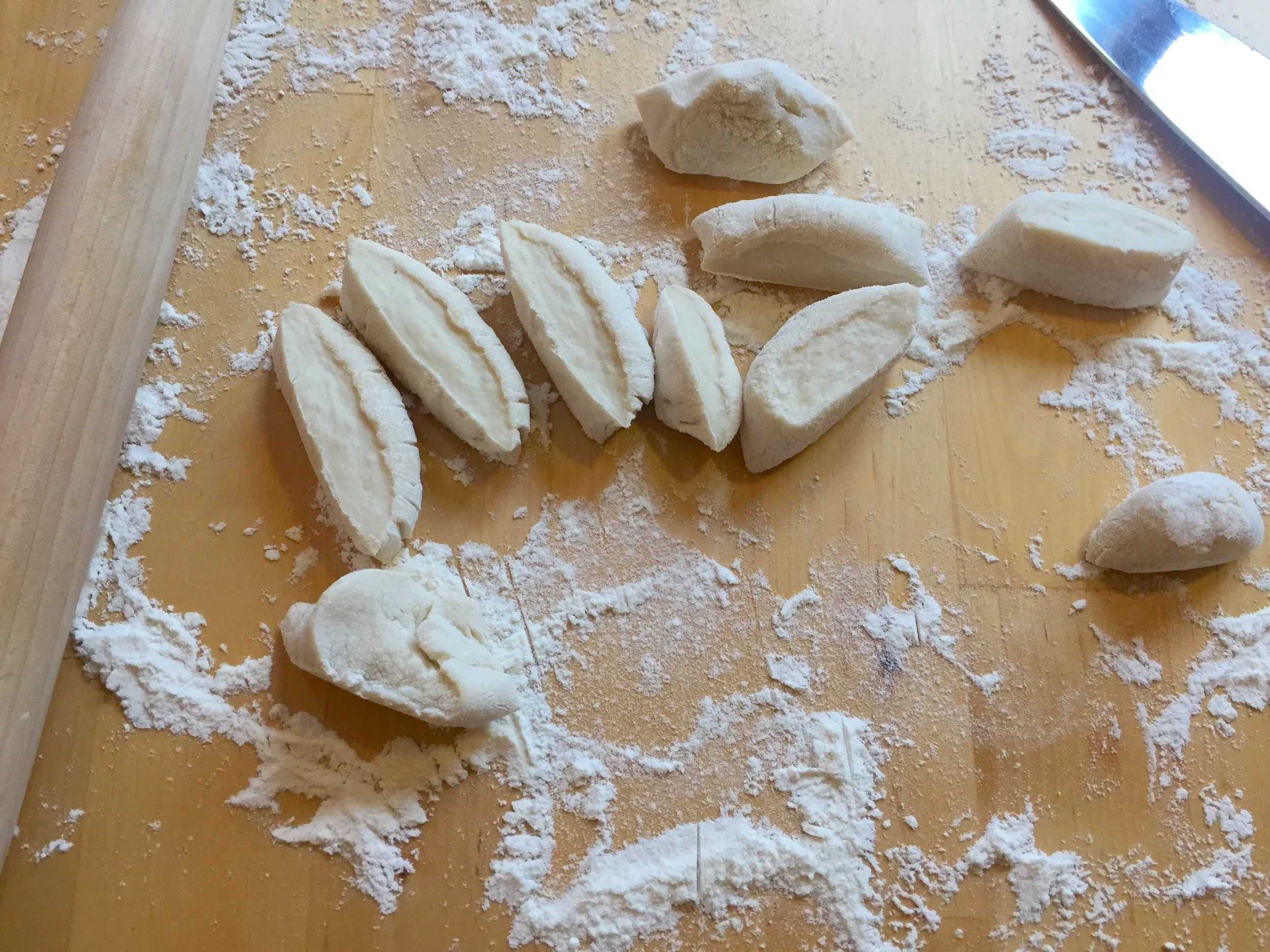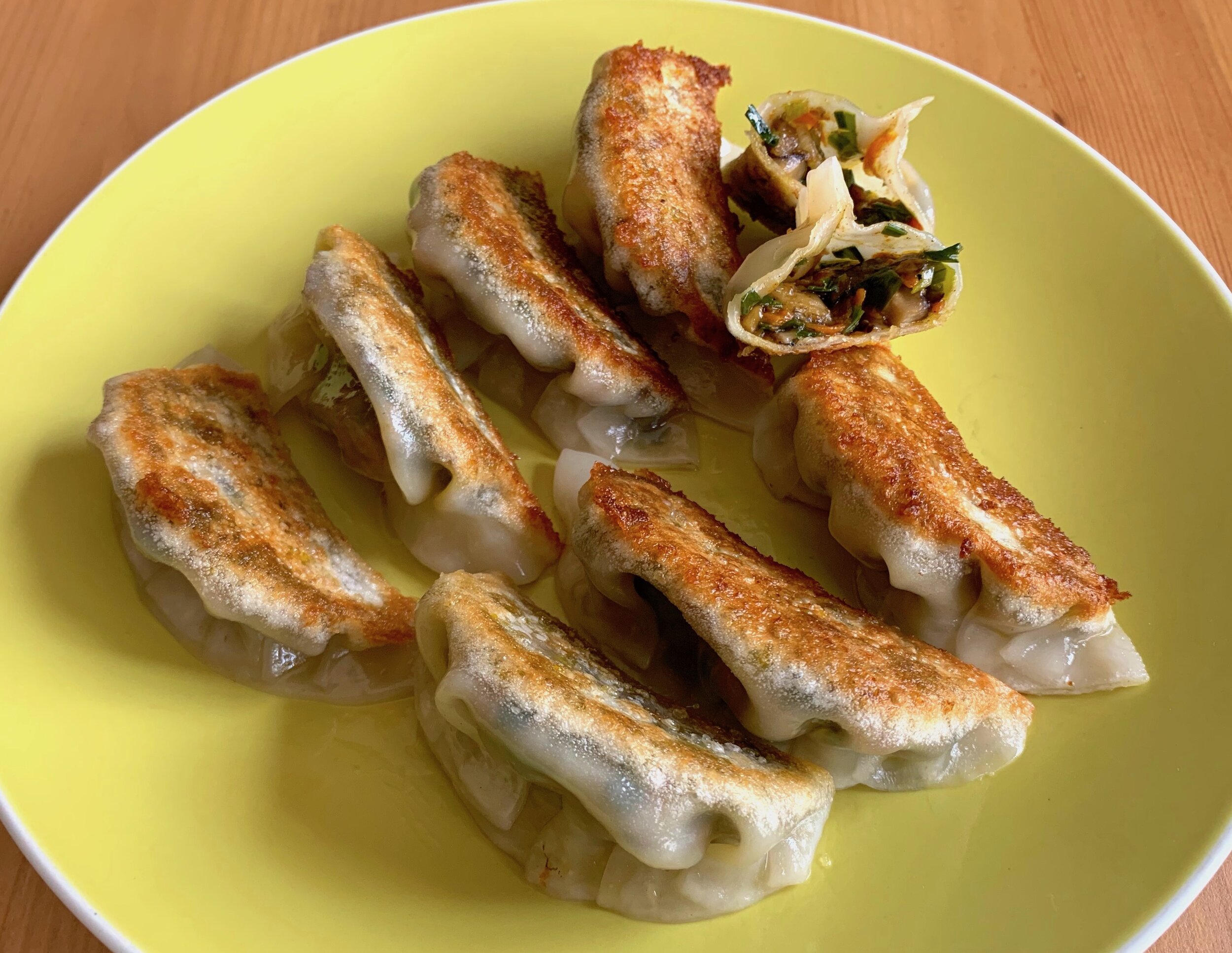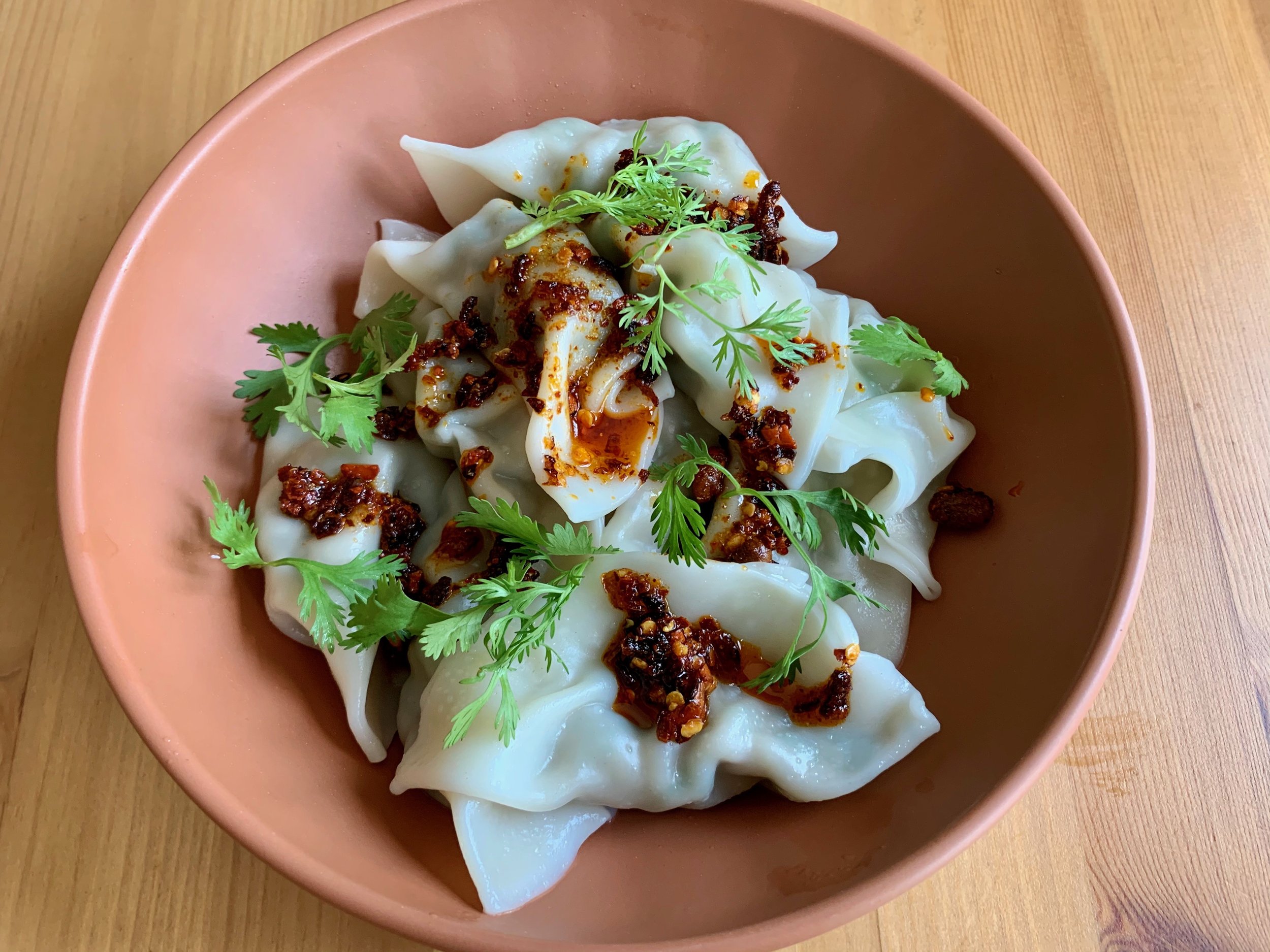Dumpling Wrappers

餃子皮 (Jiao Zi Pi)
Every dumpling begins with its wrapper, or skin [1]. Dumpling wrappers are made of a simple unleavened wheat flour dough, consisting of just flour and water. The same dough, rolled into different shapes and thicknesses, is used to make wonton wrappers, egg roll wrappers, and the skins of many Chinese pastries.
Ingredients
2 cups all-purpose flour (10 oz)
1 cup water, boiled
Premade dumpling wrappers can be found in every Asian grocery store, and are also increasingly available in American supermarkets. However, there are still some reasons to make your own: Availability—perhaps you can’t find premade wrappers in your area. Control—store-bought wrappers come in predetermined sizes and thicknesses, and for some applications we will want different geometries. Quality—homemade wrappers, especially when fresh, can have better texture, as they are generally softer and more pliable than the premade varieties.
Begin by boiling some water. Why use boiling water? For dumplings, we want enough structure to hold together under boiling or steaming, yet we want the dough to be flexible enough to fold. Hot water will denature some of the proteins in the flour and prevent as much gluten from forming, resulting in a pliable dough.
In a large mixing bowl, place two cups of all-purpose flour. Form a well and pour in 1 cup of boiling water, stirring immediately and vigorously with chopsticks or a wooden spoon. Continue stirring until a dough forms. If the dough feels too dry, add some more water—if it is too moist, add flour. At this stage the dough will likely be slightly sticky and somewhat crumbly. Begin kneading the dough together in the bowl, bringing the crumbs together into a single ball. Continue kneading for about 10 minutes, until it is smooth. Cover the dough ball with plastic or a clean tea towel, and let rest for 1 hour. As there is no leavening agent in this dough, no rise will occur. However, the dough will relax and become more elastic, which decreases the chance of tearing when we roll out the wrappers.
When the dough is rested, form it into a log about 1 inch in diameter and divide it into equal pieces for rolling out. For standard dumplings we are looking at around 40 pieces. However, depending on your application, you might be looking for thinner wrappers (wontons), or thicker wrappers (boiled dumplings), or larger wrappers for other applications. Partition your dough accordingly, dusting with flour to avoid sticking.
This dough can dry out quickly, especially when it has been divided into small pieces and rolled thin. Once it dries out, it will crack, making it difficult to wrap anything with them. For this reason, I will only cut a small number of dough pieces at a time, leaving the remaining dough log in larger pieces. Additionally, it is important to keep all dough pieces which are not being worked on covered—both the unrolled pieces and the finished wrappers.
Dust a work surface with flour, and roll the pieces out one at a time. To form the wrappers, begin by rolling the small piece of dough into a rough ball between your palms, then flattening it into a puck about 1.5 inches in diameter. Place this puck on the work surface, and place your rolling pin at the center. Roll the pin gently towards the edge, then rotate the puck by 30 degrees or so, place the rolling pin back at the center, and repeat the rolling motion towards the edge.
This is easiest with a Chinese or French rolling pin, a small, tapered, wooden rod. The roller-style American pins will not give you sufficient control when rolling. Continue turning the dough and rolling towards the edge until you form a thin circle (really doesn’t have to be a perfect circle!). If you really want perfect circles, use a cookie or pastry cutter. For dumplings, we are looking for rounds of about 3 to 3.5 inches in diameter, with a thickness of about 1/16th of an inch [2]. If you have a pasta machine, feel free to use it here. Roll the dough to the desired thickness and then cut the wrappers to shape.
Stack the wrappers on a plate, keeping them covered with plastic or a towel. Be sure that each wrapper is liberally dusted with flour, to prevent sticking. Use immediately, or freeze in an air-tight zipper bag.
Substitutions
To make egg dough wrappers, add two egg yolks to the flour before mixing, and use less water. Knead until you arrive at a smooth consistency, then proceed with the recipe.
[1] In Chinese, “jiao zi pi” translates directly to dumpling skin.
[2] For wontons we’d be looking for about half of this thickness, 1/32 of an inch. Realistically this can only be done with a pasta machine.
Recipe
Prep Time: 1 hr Cook Time: 0 min Total Time: 2 hrs
(+1 hr inactive)
Difficulty: 3/5
Heat Sources: 1 burner
Equipment: pot, rolling pin
Servings: 40 wrappers
Ingredients
2 cups all-purpose flour (10 oz)
1 cup water, boiled
Instructions
1. Place the flour in a large bowl. Pour the boiling water into the flour, and stir immediately. Continue stirring vigorously until a shaggy dough forms. Adjust the amount of water as necessary.
2. Form the dough into a ball and knead for 10 minutes, until smooth. Then let rest, covered, for 1 hour.
3. Shape the dough into a log about 1 inch in diameter, and then cut into 40 equal pieces, dusting them with flour so they do not stick. Cover the pieces with plastic wrap or a clean tea towel.
4. Dust your work surface with flour and roll the pieces out one at a time into rounds of 3-3.5 inches in diameter, and a thickness of about 1/16th of an inch. Form a stack of wrappers, and keep the stack covered.
5. Use immediately, or freeze in a zipper bag.










